
Human-powered transport
Encyclopedia
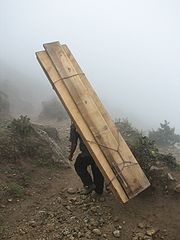
Transport
Transport or transportation is the movement of people, cattle, animals and goods from one location to another. Modes of transport include air, rail, road, water, cable, pipeline, and space. The field can be divided into infrastructure, vehicles, and operations...
of person(s) and/or goods using human
Human
Humans are the only living species in the Homo genus...
muscle
Muscle
Muscle is a contractile tissue of animals and is derived from the mesodermal layer of embryonic germ cells. Muscle cells contain contractile filaments that move past each other and change the size of the cell. They are classified as skeletal, cardiac, or smooth muscles. Their function is to...
power. Like animal-powered transport
Animal-powered transport
Animal-powered transport is a broad category of the human use of non-human working animals for the movement of people and goods....
, human-powered transport has existed since time immemorial
Time immemorial
Time immemorial is a phrase meaning time extending beyond the reach of memory, record, or tradition, indefinitely ancient, "ancient beyond memory or record"...
in the form of walking
Walking
Walking is one of the main gaits of locomotion among legged animals, and is typically slower than running and other gaits. Walking is defined by an 'inverted pendulum' gait in which the body vaults over the stiff limb or limbs with each step...
, running
Running
Running is a means of terrestrial locomotion allowing humans and other animals to move rapidly on foot. It is simply defined in athletics terms as a gait in which at regular points during the running cycle both feet are off the ground...
and swimming. Modern technology
Technology
Technology is the making, usage, and knowledge of tools, machines, techniques, crafts, systems or methods of organization in order to solve a problem or perform a specific function. It can also refer to the collection of such tools, machinery, and procedures. The word technology comes ;...
has allowed machine
Machine
A machine manages power to accomplish a task, examples include, a mechanical system, a computing system, an electronic system, and a molecular machine. In common usage, the meaning is that of a device having parts that perform or assist in performing any type of work...
s to enhance human-power.
Although motorization
Automobile
An automobile, autocar, motor car or car is a wheeled motor vehicle used for transporting passengers, which also carries its own engine or motor...
has increased speed and load capacity, many forms of human-powered transport remain popular for reasons of lower cost, leisure
Leisure
Leisure, or free time, is time spent away from business, work, and domestic chores. It is also the periods of time before or after necessary activities such as eating, sleeping and, where it is compulsory, education....
, physical exercise
Physical exercise
Physical exercise is any bodily activity that enhances or maintains physical fitness and overall health and wellness. It is performed for various reasons including strengthening muscles and the cardiovascular system, honing athletic skills, weight loss or maintenance, as well as for the purpose of...
and environmentalism
Environmentalism
Environmentalism is a broad philosophy, ideology and social movement regarding concerns for environmental conservation and improvement of the health of the environment, particularly as the measure for this health seeks to incorporate the concerns of non-human elements...
. Human-powered transport is sometimes the only type available, especially in underdeveloped or inaccessible regions.
Available muscle power
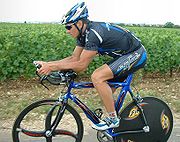
Race Across America
The Race Across America, or RAAM, is an ultra marathon bicycle race across the United States that started in 1982 as the Great American Bike Race....
, one team (Team Strawberry
Team Strawberry
Team Strawberry was a professional bicycle racing team that participated in experiments on human power/performance conducted by their primary sponsor, Balboa Instruments of Newport Beach, California. The Team was founded in 1988 by team captain Alan R. McDonald...
) used an experimental device that consisted of a rear wheel hub, a sensor and a handlebar mounted processor. The device measured each cyclist's power output in watts. In lab experiments an average "in-shape" cyclist can produce about 3 watts/kg for more than an hour (e.g., around 200 watts for a 70 kg rider), with top amateurs producing 5 watts/kg and elite athletes achieving 6 watts/kg for similar lengths of time. Elite track sprint cyclists are able to attain an instantaneous maximum output of around 2,000 watts, or in excess of 25 watts/kg; elite road cyclists may produce 1,600 to 1,700 watts as an instantaneous maximum in their burst to the finish line at the end of a five-hour-long road race.
Non-vehicular
- Crawling
- WalkingWalkingWalking is one of the main gaits of locomotion among legged animals, and is typically slower than running and other gaits. Walking is defined by an 'inverted pendulum' gait in which the body vaults over the stiff limb or limbs with each step...
(240 wattWattThe watt is a derived unit of power in the International System of Units , named after the Scottish engineer James Watt . The unit, defined as one joule per second, measures the rate of energy conversion.-Definition:...
s) - RunningRunningRunning is a means of terrestrial locomotion allowing humans and other animals to move rapidly on foot. It is simply defined in athletics terms as a gait in which at regular points during the running cycle both feet are off the ground...
(1000 wattWattThe watt is a derived unit of power in the International System of Units , named after the Scottish engineer James Watt . The unit, defined as one joule per second, measures the rate of energy conversion.-Definition:...
s) - Sprinting (1700 wattWattThe watt is a derived unit of power in the International System of Units , named after the Scottish engineer James Watt . The unit, defined as one joule per second, measures the rate of energy conversion.-Definition:...
s at 25 km/h) - Swimming and divingDivingDiving is the sport of jumping or falling into water from a platform or springboard, sometimes while performing acrobatics. Diving is an internationally-recognized sport that is part of the Olympic Games. In addition, unstructured and non-competitive diving is a recreational pastime.Diving is one...
- ClimbingClimbingClimbing is the activity of using one's hands and feet to ascend a steep object. It is done both for recreation and professionally, as part of activities such as maintenance of a structure, or military operations.Climbing activities include:* Bouldering: Ascending boulders or small...
as in mountaineeringMountaineeringMountaineering or mountain climbing is the sport, hobby or profession of hiking, skiing, and climbing mountains. While mountaineering began as attempts to reach the highest point of unclimbed mountains it has branched into specialisations that address different aspects of the mountain and consists...
and abseilingAbseilingAbseiling , rappelling in American English, is the controlled descent down a rock face using a rope; climbers use this technique when a cliff or slope is too steep and/or dangerous to descend without protection.- Slang terms :...
Human-powered vehicles (HPV)
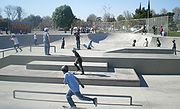
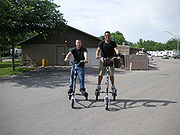
- CanoeingCanoeingCanoeing is an outdoor activity that involves a special kind of canoe.Open canoes may be 'poled' , sailed, 'lined and tracked' or even 'gunnel-bobbed'....
and kayakingKayakingKayaking is the use of a kayak for moving across water. Kayaking and canoeing are also known as paddling. Kayaking is distinguished from canoeing by the sitting position of the paddler and the number of blades on the paddle... - Caster BoardCaster boardA Casterboard, also known as a Waveboard, is a two-wheeled, human-powered land vehicle that is closely related to the skateboard and the snakeboard. Two narrow platforms known as "decks" are joined by a "torsion bar", which consists of a metal beam, usually coated by rubber, that houses a strong...
- Cross-country skiingCross-country skiingCross-country skiing is a winter sport in which participants propel themselves across snow-covered terrain using skis and poles...
- CyclingCyclingCycling, also called bicycling or biking, is the use of bicycles for transport, recreation, or for sport. Persons engaged in cycling are cyclists or bicyclists...
using a bicycleBicycleA bicycle, also known as a bike, pushbike or cycle, is a human-powered, pedal-driven, single-track vehicle, having two wheels attached to a frame, one behind the other. A person who rides a bicycle is called a cyclist, or bicyclist....
, unicycleUnicycleA unicycle is a human-powered, single-track vehicle with one wheel. Unicycles resemble bicycles, but are less complex.-History:One theory of the advent of the unicycle stems from the popularity of the penny-farthing during the late 19th century...
, tricycleTricycleA tricycle is a three-wheeled vehicle. While tricycles are often associated with the small three-wheeled vehicles used by pre-school-age children, they are also used by adults for a variety of purposes. In the United States and Canada, adult-sized tricycles are used primarily by older persons for...
, quadracycle, velomobileVelomobileA velomobile or bicycle car is a human-powered vehicle, enclosed for aerodynamic advantage and protection from weather and collisions. They are virtually always single-passenger vehicles. They are derived from recumbent bicycles and tricycles, with the addition of a full fairing . There are few...
or similar wheeled vehicle, including collective variations such as tandem bicycleTandem bicycleThe tandem bicycle or twin is a form of bicycle designed to be ridden by more than one person. The term tandem refers to the seating arrangement , not the number of riders. A bike with two riders side-by-side is called a sociable.-History:Patents related to tandem bicycles date from the late 19th...
and side-car - DraisineDraisineA draisine primarily refers to a light auxiliary rail vehicle, driven by service personnel, equipped to transport crew and material necessary for the maintenance of railway infrastructure....
- HandcyclesHandcyclesA handcycle is a type of human powered land vehicle powered by the arms rather than the legs, as on a bicycle. Most handcycles are tricycle in form, with two coasting rear wheels and one steerable powered front wheel. Despite usually having three wheels, they are also known as handbikes.Many...
- Human-powered hydrofoilHuman-powered hydrofoilthumb|Starting an AquaSkipper on the river [[Spree]] in [[Berlin]]A human-powered hydrofoil is a small hydrofoil watercraft propelled entirely by the muscle power of its operator. Human-powered hydrofoils may be driven by pedals, as in a hydrocycle, by paddles, as in a Flyak, or by bouncing, as in...
- Ice skatingIce skatingIce skating is moving on ice by using ice skates. It can be done for a variety of reasons, including leisure, traveling, and various sports. Ice skating occurs both on specially prepared indoor and outdoor tracks, as well as on naturally occurring bodies of frozen water, such as lakes and...
- Inline SkatingInline skatingInline skating is a recreational sport practiced widely internationally. Inline skates typically have 2 to 5 polyurethane wheels, arranged in a single line. The in-line design allows for greater speed than roller skates and better maneuverability...
- Kick scooterKick scooterA kick scooter or push scooter, originally scooter, is a human-powered vehicle with a handlebar, deck and wheels that is propelled by a rider pushing off the ground. The most common scooters today have two hard small wheels, are made primarily of aluminium and fold for convenience...
- KicksledKicksledThe kicksled or spark is a small sled consisting of a chair mounted on a pair of flexible metal runners which extend backward to about twice the chair's length. The sled is propelled by kicking the ground by foot. There is a handlebar attached to the top of the chair back...
- Human-powered aircraftHuman-powered aircraftA human-powered aircraft is an aircraft powered by direct human energy and the force of gravity; the thrust provided by the human may be the only source; however, a hang glider that is partially powered by pilot power is a human-powered aircraft where the flight path can be enhanced more than if...
- Powerbocking
- PuntingPunt (boat)A punt is a flat-bottomed boat with a square-cut bow, designed for use in small rivers or other shallow water. Punting refers to boating in a punt. The punter generally propels the punt by pushing against the river bed with a pole...
- Roller skatingRoller skatingRoller skating is the traveling on smooth surfaces with roller skates. It is a form of recreation as well as a sport, and can also be a form of transportation. Skates generally come in two basic varieties: quad roller skates and inline skates or blades, though some have experimented with a...
- Rowing cycle
- RowingWatercraft rowingWatercraft rowing is the act of propelling a boat using the motion of oars in the water. The difference between paddling and rowing is that with rowing the oars have a mechanical connection with the boat whereas with paddling the paddles are hand-held with no mechanical connection.This article...
- SkateboardingSkateboardingSkateboarding is an action sport which involves riding and performing tricks using a skateboard.Skateboarding can be a recreational activity, an art form, a job, or a method of transportation. Skateboarding has been shaped and influenced by many skateboarders throughout the years. A 2002 report...
and LongboardingLongboardingLongboarding is the act of riding on a longboard.Longboarding is an offshoot of street skating, but, like all board sports, its roots lie in surfing. Developed as a single sport on the west coast in the 1950s, by the 1990s, Longboards and Skateboards branched off into their respective disciplines... - TrikkeTrikkethumb|The Trikke works by shifting body weightThe Trikke three-wheeled cambering vehicles are human powered machines that utilize Trikke Tech’s patented technology to allow a rider to propel a chainless, pedal-less device forward without ever touching foot to ground...
Vehicles for transporting others
- StretcherStretcherA stretcher is a medical device used to carry casualties or an incapacitated person from one place to another. It is a simple type of litter, and still called by that name in some cases....
- TravoisTravoisA travois is a frame used by indigenous peoples, notably the Plains Indians of North America, to drag loads over land...
- Litters, e.g. Sedan chairLitter (vehicle)The litter is a class of wheelless vehicles, a type of human-powered transport, for the transport of persons. Examples of litter vehicles include lectica , jiao [较] , sedan chairs , palanquin , Woh , gama...
- Pulled rickshaw
- Cycle rickshawCycle rickshawThe cycle rickshaw is a small-scale local means of transport; it is also known by a variety of other names such as velotaxi, pedicab, bikecab, cyclo, becak, trisikad, or trishaw or, simply, rickshaw which also refers to auto rickshaws, and the, now uncommon, rickshaws pulled by a person on foot...
- HandcarHandcarA handcar is a railroad car powered by its passengers, or by people pushing the car from behind. It is mostly used as a maintenance of way or mining car, but it was also used for passenger service in some cases...
- BicycleBicycleA bicycle, also known as a bike, pushbike or cycle, is a human-powered, pedal-driven, single-track vehicle, having two wheels attached to a frame, one behind the other. A person who rides a bicycle is called a cyclist, or bicyclist....
- GondolaGondolaThe gondola is a traditional, flat-bottomed Venetian rowing boat, well suited to the conditions of the Venetian Lagoon. For centuries gondolas were the chief means of transportation and most common watercraft within Venice. In modern times the iconic boats still have a role in public transport in...
- Galley
- GurneyGurneyA gurney, known as a trolley in British medical context, is the U.S. term for a type of stretcher used in modern hospitals and ambulances in developed areas. A hospital gurney is a kind of narrow bed on a wheeled frame which may be adjustable in height. For ambulances, a collapsible gurney is a...
, for medical transport
Some of the vehicles also transport cargo and/or passengers.
Human-powered land vehicles
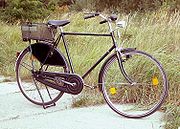

Handcar
A handcar is a railroad car powered by its passengers, or by people pushing the car from behind. It is mostly used as a maintenance of way or mining car, but it was also used for passenger service in some cases...
(a human-powered railroad car), normally travel at ground level but can also travel above (for example, on a trestle
Trestle
A trestle is a rigid frame used as a support, especially referring to a bridge composed of a number of short spans supported by such frames. In the context of trestle bridges, each supporting frame is generally referred to as a bent...
) and below ground (such as when used in mining
Mining
Mining is the extraction of valuable minerals or other geological materials from the earth, from an ore body, vein or seam. The term also includes the removal of soil. Materials recovered by mining include base metals, precious metals, iron, uranium, coal, diamonds, limestone, oil shale, rock...
).
Skateboards have the advantage of being so small and light that users can easily carry them when not skating.
The most efficient human-powered land vehicle is the bicycle
Bicycle
A bicycle, also known as a bike, pushbike or cycle, is a human-powered, pedal-driven, single-track vehicle, having two wheels attached to a frame, one behind the other. A person who rides a bicycle is called a cyclist, or bicyclist....
. Compared to the much more common upright bicycle, the recumbent bicycle
Recumbent bicycle
A recumbent bicycle is a bicycle that places the rider in a laid-back reclining position. Most recumbent riders choose this type of design for ergonomic reasons; the rider's weight is distributed comfortably over a larger area, supported by back and buttocks...
may be faster on level ground or down hills due to better aerodynamics
Aerodynamics
Aerodynamics is a branch of dynamics concerned with studying the motion of air, particularly when it interacts with a moving object. Aerodynamics is a subfield of fluid dynamics and gas dynamics, with much theory shared between them. Aerodynamics is often used synonymously with gas dynamics, with...
while having similar power transfer efficiency. In 2009, Sam Whittingham
Sam Whittingham
Sam Whittingham is a Canadian cyclist who has held several world records on recumbent bicycles., he holds the following world records under the sanction of the International Human Powered Vehicle Association:...
pedaled a streamliner (a fully faired recumbent) for 200 m (656.2 ft) at 133.284 km/h (82.8 mph) in the Varna Tempest.
Velomobile
Velomobile
A velomobile or bicycle car is a human-powered vehicle, enclosed for aerodynamic advantage and protection from weather and collisions. They are virtually always single-passenger vehicles. They are derived from recumbent bicycles and tricycles, with the addition of a full fairing . There are few...
s and cabin cycle
Cabin cycle
A cabin cycle is a form of land vehicle with a hull that wraps around the basic bicycle or motorcycle design. Unlike traditional designs, the chassis can be moulded to reduce drag when travelling at high speeds. Some 3-wheeled variants are commonly known as auto rickshaws or tuk-tuks. In Czech...
s are increasingly popular in colder and/or wetter countries due to the protection they offer against the environment. Freight bicycle
Freight bicycle
Freight bicycles, carrier cycles, freight tricycles, cargo bikes, or bakfietsen, are human powered vehicles designed and constructed specifically for transporting large loads. Vehicle designs include a cargo area consisting of a steel tube carrier, an open or enclosed box, a flat platform, or a...
s are used as low-cost, zero-emission vehicles to haul cargo
Cargo
Cargo is goods or produce transported, generally for commercial gain, by ship, aircraft, train, van or truck. In modern times, containers are used in most intermodal long-haul cargo transport.-Marine:...
. Cycle rickshaw
Cycle rickshaw
The cycle rickshaw is a small-scale local means of transport; it is also known by a variety of other names such as velotaxi, pedicab, bikecab, cyclo, becak, trisikad, or trishaw or, simply, rickshaw which also refers to auto rickshaws, and the, now uncommon, rickshaws pulled by a person on foot...
s can be used as taxicab
Taxicab
A taxicab, also taxi or cab, is a type of vehicle for hire with a driver, used by a single passenger or small group of passengers, often for a non-shared ride. A taxicab conveys passengers between locations of their choice...
s.
Dutch cyclist, Fred Rompelberg
Fred Rompelberg
Fred Rompelberg is a Dutch cyclist who has set several world cycling records. He is mainly known for his eleven world records cycling behind heavy engines, and for taking several attempts to break the Absolute World Speed Record Cycling...
set a 268.8 km/h (167 mph) speed record at the Bonneville Salt Flats in Utah
Utah
Utah is a state in the Western United States. It was the 45th state to join the Union, on January 4, 1896. Approximately 80% of Utah's 2,763,885 people live along the Wasatch Front, centering on Salt Lake City. This leaves vast expanses of the state nearly uninhabited, making the population the...
on October 3, 1995 while cycling in the wake of a motor dragster pace-car. The wake of the pace-car reduced the aerodynamic drag against which Rompelberg pedalled to almost zero.
Greg Kolodziejzyk set two world records recognized by both the International Human Powered Vehicle Association and Guinness (TM) World Records on July 17, 2006 on a race track in Eureka, California
Eureka, California
Eureka is the principal city and the county seat of Humboldt County, California, United States. Its population was 27,191 at the 2010 census, up from 26,128 at the 2000 census....
. The first record is for the most distance traveled in 24 hours by human power 1041 km (646.8 mi), and the second for the worlds fastest 1,000 km time trial (23 hours, 2 minutes).
In 1969, artists in a small Northern California town began the Kinetic sculpture race
Kinetic sculpture race
Kinetic sculpture races are organized contests of human-powered amphibious all-terrain works of art. The original event, the Kinetic Grand Championship in Humboldt County, California, is also called the "Triathlon of the Art World" because art and engineering are combined with physical endurance...
which has grown to a 42 mi (67.6 km), three-day all terrain, human-powered sculpture race and county wide event. It is held every year on the last weekend in May.
Fixed-wing aircraft
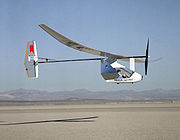
The first officially authenticated regularly feasible take-off and landing of a human-powered aircraft (one capable of powered takeoffs, unlike a glider
Glider aircraft
Glider aircraft are heavier-than-air craft that are supported in flight by the dynamic reaction of the air against their lifting surfaces, and whose free flight does not depend on an engine. Mostly these types of aircraft are intended for routine operation without engines, though engine failure can...
) was made on 9 November 1961 by Derek Piggott
Derek Piggott
Alan Derek Piggott MBE is one of Britain's best known glider pilots and instructors. His flying career has been long and varied. He first flew in an Avro 504 as a passenger at the age of four...
in Southampton University's Man Powered Aircraft (SUMPAC
SUMPAC
-See also:-Bibliography:* Guttery, T.E. The Shuttleworth Collection. London: Wm. Carling & Co, 1969. SBN 901319-01-5*...
).
Perhaps the best-known human-powered plane is the Gossamer Albatross
Gossamer Albatross
-See also:-Further reading:*Allen, Bryan. Winged Victory of "Gossamer Albatross". National Geographic, November 1979, vol. 156, n. 5, p. 640-651...
, which flew across the English Channel
English Channel
The English Channel , often referred to simply as the Channel, is an arm of the Atlantic Ocean that separates southern England from northern France, and joins the North Sea to the Atlantic. It is about long and varies in width from at its widest to in the Strait of Dover...
in 1979.
The current distance and duration record recognised by the FAI was achieved on 23 April 1988 from Iraklion on Crete to Santorini in a MIT Daedalus
MIT Daedalus
The MIT Aeronautics and Astronautics Department's Daedalus was a human-powered aircraft that, on 23 April 1988, flew a distance of 71.5 mi in 3 hours, 54 minutes, from Iraklion on the island of Crete to the island of Santorini...
88 piloted by Kanellos Kanellopoulos: a straight distance of 115.11 km (71.5 mi) in 3 hours, 54 minutes.
The current speed record is held by the Monarch B, built by a team at MIT in 1983, which won a Kremer Prize of £20,000 for sustaining a speed of over 30 km/h over a 1.5 km triangular course.
Helicopters
The first officially observed human-powered helicopter to have left the ground was the Da Vinci III in 1989. It was designed and built by students at Cal Poly San Luis Obispo in California, USA. It flew for 7.1 seconds and reached a height of 8 inches (20 cm). The second was the Yuri I in 1994, designed and built by students at Nihon University in Japan. It flew for 19.46 seconds and reached an altitude of 20 cm. Both were attempts to win the Sikorsky PrizeSikorsky Prize
The Sikorsky Prize is a $250,000 reward established in 1980 by the American Helicopter Society to the first controlled flight of a human powered helicopter. It was named in honor of Igor Sikorsky. The prize has not yet been won...
.
Airships and balloons
FrenchFrance
The French Republic , The French Republic , The French Republic , (commonly known as France , is a unitary semi-presidential republic in Western Europe with several overseas territories and islands located on other continents and in the Indian, Pacific, and Atlantic oceans. Metropolitan France...
inventors have built man-powered airship
Airship
An airship or dirigible is a type of aerostat or "lighter-than-air aircraft" that can be steered and propelled through the air using rudders and propellers or other thrust mechanisms...
s and balloons. Solar balloon
Solar balloon
A solar balloon is a balloon that gains buoyancy when the air inside is heated by the sun's radiation, usually with the help of black or dark balloon material. The heated air inside the solar balloon expands and has lower density than the surrounding air. As such, a solar balloon is similar to a...
s and solar airships are new types of balloons and airships. Because lift is supplied through buoyancy, human power can be devoted to thrust.
Human-powered watercraft


Pedalo
A paddle boat or "pedalo" is a form of waterborne transport, primarily for recreational use, powered through the use of pedals....
s.
Hydrofoil
Hydrofoils have less water resistance at the highest speeds just obtainable by humans and are thus usually faster than displacement boats on short courses. The world speed record on water was set 27 October 1991 by MIT Professor Mark Drela who pedalled a human-powered hydrofoilHuman-powered hydrofoil
thumb|Starting an AquaSkipper on the river [[Spree]] in [[Berlin]]A human-powered hydrofoil is a small hydrofoil watercraft propelled entirely by the muscle power of its operator. Human-powered hydrofoils may be driven by pedals, as in a hydrocycle, by paddles, as in a Flyak, or by bouncing, as in...
, "Decavitator
Decavitator
The Decavitator is a human-powered hydrofoil that was built by the Massachusetts Institute of Technology. It holds the human-powered speed record on water...
", to 18.5 knots (21.3 mph)(9.53 meters/second) over a 100 meter race course in Boston
Boston
Boston is the capital of and largest city in Massachusetts, and is one of the oldest cities in the United States. The largest city in New England, Boston is regarded as the unofficial "Capital of New England" for its economic and cultural impact on the entire New England region. The city proper had...
, Massachusetts.
Submarines
In 1989, the first human-powered International Submarine Race (ISR) was held in Florida with 17 craft. Since then nine more races have been held. The races themselves have been moved from the waters of Florida to the United States Naval Surface Warfare Center's Carderock Division David Taylor Model Basin in Bethesda, Maryland, and are held biennially. At the 9th ISR in 2007 (in which 23 submarines participated) several new records were set: A single-person craft, Omer5 achieved a record speed of 8.035 knots breaking the Omer team's previous record of 7.19 knots set by Omer 4 in 2004. Also Omer 6 snatched up a record for non-propeller driven craft with a speed of 4.642 knots.See also
- Adirondack guideboatAdirondack guideboatAdirondack guideboats were built since the early 19th century and evolved from a hunting skiff to today's highly refined design, virtually unchanged since the late 19th century...
- Animal locomotionAnimal locomotionAnimal locomotion, which is the act of self-propulsion by an animal, has many manifestations, including running, swimming, jumping and flying. Animals move for a variety of reasons, such as to find food, a mate, or a suitable microhabitat, and to escape predators...
- Animal-powered transportAnimal-powered transportAnimal-powered transport is a broad category of the human use of non-human working animals for the movement of people and goods....
- Bicycle and human powered vehicle museums, list of
- Carfree CitiesCarfree CitiesA carfree city is a population center that relies primarily on public transport, walking, or cycling for transport within the urban area. Carfree cities greatly reduce petroleum dependency, air pollution, greenhouse emissions, automobile crashes, noise pollution, and traffic congestion...
- Fuel efficiency in transportationFuel efficiency in transportationThe fuel efficiency in transportation ranges from some hundred kilojoule per kilometre for a bicycle to several megajoule for a helicopter.Efficiency can be expressed in terms of consumption per unit distance per vehicle, consumption per unit distance per passenger or consumption per unit distance...
- International Human Powered Vehicle AssociationInternational Human Powered Vehicle AssociationThe International Human Powered Vehicle Association is dedicated to promoting the design and development of human powered vehicles.- History :...
- Row boat
- Rowing (sport)Rowing (sport)Rowing is a sport in which athletes race against each other on rivers, on lakes or on the ocean, depending upon the type of race and the discipline. The boats are propelled by the reaction forces on the oar blades as they are pushed against the water...
- ScullingScullingSculling generally refers to a method of using oars to propel watercraft in which the oar or oars touch the water on both the port and starboard sides of the craft, or over the stern...
- Self-propelled travelSelf-propelled travelSelf-propelled travel is a type of recreational adventure travel using human powered transport. This includes non-motorized machines such as a bicycle or skateboard...
- SidewalkSidewalkA sidewalk, or pavement, footpath, footway, and sometimes platform, is a path along the side of a road. A sidewalk may accommodate moderate changes in grade and is normally separated from the vehicular section by a curb...
- Utility cyclingUtility cyclingUtility cycling encompasses any cycling not done primarily for fitness, recreation such as cycle touring, or sport such as cycle racing, but simply as a means of transport...
- Watercraft rowingWatercraft rowingWatercraft rowing is the act of propelling a boat using the motion of oars in the water. The difference between paddling and rowing is that with rowing the oars have a mechanical connection with the boat whereas with paddling the paddles are hand-held with no mechanical connection.This article...
External links
- Human Powered Vehicle Records
- Human Powered Vehicle Challenge - American Society Of Mechanical Engineers
Air
- Human Powered Aircraft Group - Virginia Tech
- Human Powered Helicopters - History, technology, people
Water
- Human Powered Boats - Events, photos, links
- Human Powered Hydrofoils from 1953 to 2005
- Decavitator Human-Powered Hydrofoil - videos, documentation
- Human Powered Submarine of Virginia Tech
Land
- Rose-Hulman Institute of Technology Human Powered Vehicle Team - Videos, photos, links, and other information about human powered land vehicles

